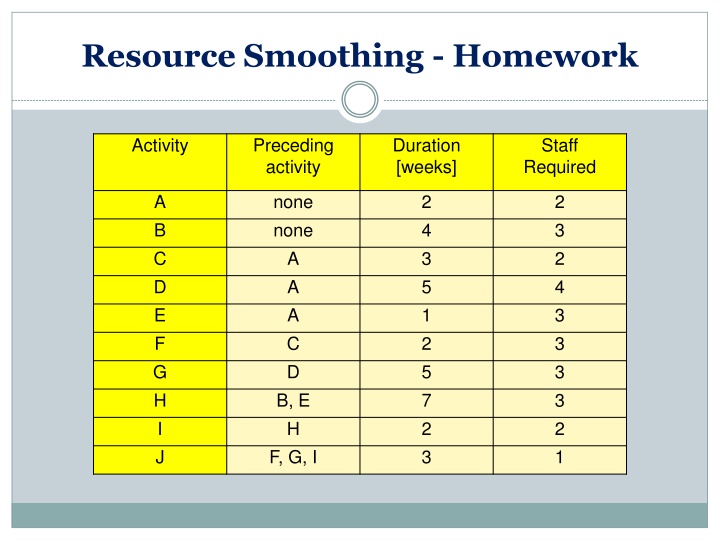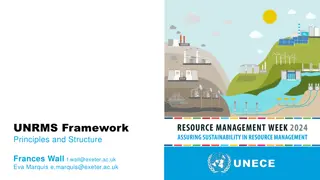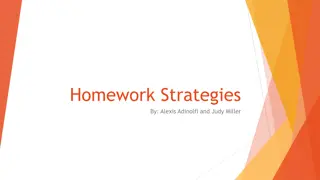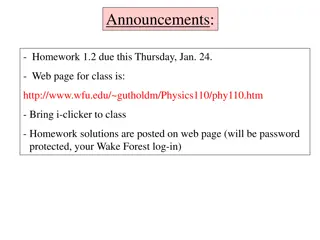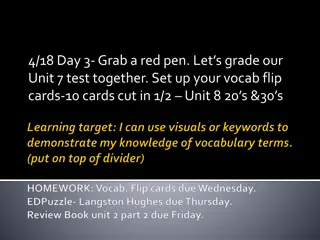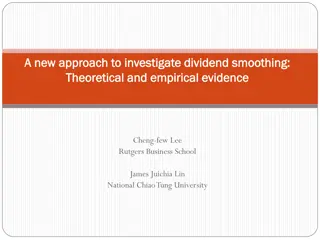Resource Smoothing in Homework Activities
Resource smoothing in homework activities involves adjusting the allocation of staff over time to optimize project scheduling. Various scenarios and strategies are explored to enhance efficiency and meet project deadlines effectively. Through visual aids and network analysis results, different possibilities to shorten project durations are considered, including the impact of additional resources and technologies. A case study on earthquake-related bridge construction showcases the practical application of resource smoothing techniques.
Download Presentation

Please find below an Image/Link to download the presentation.
The content on the website is provided AS IS for your information and personal use only. It may not be sold, licensed, or shared on other websites without obtaining consent from the author.If you encounter any issues during the download, it is possible that the publisher has removed the file from their server.
You are allowed to download the files provided on this website for personal or commercial use, subject to the condition that they are used lawfully. All files are the property of their respective owners.
The content on the website is provided AS IS for your information and personal use only. It may not be sold, licensed, or shared on other websites without obtaining consent from the author.
E N D
Presentation Transcript
Resource Smoothing - Homework Activity Preceding activity Duration [weeks] Staff Required A B C D E F G H I J none none A A A C D B, E H F, G, I 2 4 3 5 1 2 5 7 2 3 2 3 2 4 3 3 3 3 2 1
Resource Smoothing - Homework 0 1 1 2 2 3 2 6 8 5 3 11 5 6 11 7 2 13 A C F 0 0 0 0 0 0 St 2 1 3 7 5 8 7 1 8 12 5 13 D G 13 0 13 16 3 16 16 0 16 16 0 16 J En 2 1 3 3 1 4 E 0 0 0 4 4 4 4 0 4 11 7 11 11 0 11 13 2 13 B H I
Resource Smoothing - Homework All activities start as early as possible: Time 1 2 3 4 5 6 7 8 9 10 11 12 13 14 15 16 Activity A 2 2 B 3 3 3 3 C 2 2 2 D 4 4 4 4 4 E 3 F 3 3 G 3 3 3 3 3 H 3 3 3 3 3 3 3 I 2 2 J 1 1 1 Suma 5 5 12 9 9 10 10 6 6 6 6 5 2 1 1 1
Resource Smoothing - Homework Non-critical activity C has been delayed and the following activities too: Time 1 2 3 4 5 6 7 8 9 10 11 12 13 14 15 16 Activity A 2 2 B 3 3 3 3 C 2 2 2 D 4 4 4 4 4 E 3 F 3 3 G 3 3 3 3 3 H 3 3 3 3 3 3 3 I 2 2 J 1 1 1 Suma 5 5 10 9 9 9 10 9 6 6 6 5 2 1 1 1
Resource Smoothing - Homework Non-critical activities C and D have been delayed and the following activities too: Time 1 2 3 4 5 6 7 8 9 10 11 12 13 14 15 16 Activity A 2 2 B 3 3 3 3 C 2 2 2 D 4 4 4 4 4 E 3 F 3 3 G 3 3 3 3 3 H 3 3 3 3 3 3 3 I 2 2 J 1 1 1 Suma 5 5 6 7 7 7 7 7 8 8 8 8 8 1 1 1
Resource Smoothing - Homework Two possible scenarios of resource smoothing:
Crashing Durations Network Analysis Results Is the project completion time provided by CPM really the shortest possible? Based on the data provided there is no possibility to make the project duration shorter. BUT What about if more people are available? What if new machinery can be employed? What is a different technology is applicable? How much money do we have?
Crashing Durations Case Study Earthquake in CA In January 1994, the Northridge earthquake in Southern California damaged ten bridges on the Santa Monica Freeway in Los Angeles. C.C. Myers, Inc. won the contract to replace the bridges. The contract specified that the work had to be completed in 140 days. The closure of the freeway was estimated to cost the economy of the area as much as $1M per day.
Crashing Durations Case Study Earthquake in CA The State of California, understanding the loss to the LA economy that was caused by the freeway being down, offered a $200,000 per day bonus for each day prior to the 140 days deadline C.C. Myers, Inc. Took the challenge: Greatly expanded workforce (e.g. 134 ironworkers instead of 15) Special lighting equipment allowed them to work 24 hours a day Special materials were used in order to avoid weather influence Generous incentive scheme was introduced for teams of workers The work was scheduled as an assembly line etc.
Crashing Durations Case Study Earthquake in CA With the cooperation and extra effort from Caltrans, the City of Los Angeles, the workers, and even the citizens of LA, the company completed the job in 66 days, a full 74 days ahead of schedule. The $14.8M bonus is the largest early completion bonus paid by Caltrans. It is evident that by adding more resources we can (sometimes) further shorten the project duration!
Crashing Durations Case Study SureFlight SureFlight Ground Services PLC has been providing a wide range of services at airports and to airline companies. Recently it has expanded its operations into the field of aircraft maintenance. The Civil Aviation authorities require that all aircraft are subjected to rigorous maintenance inspection at stipulated regular intervals. The expansion is part of the long term strategy of SureFlight in accordance with its mission to be "... the leading provider of a complete range of high quality civil aircraft services... '. The timing of the decision to proceed coincides with an opportunity to tender for a five year contract to provide the maintenance for the Airbus fleet of a major international passenger airline.
Crashing Durations Case Study SureFlight The requirements spelled out in the tender documents cover full maintenance of the aircraft engines, its airframe and fuel tanks and all landing gear. After the aircraft has been checked in and all the relevant data recorded it will be moved to a maintenance hangar and positioned ready for work to begin. The first activities are concerned with conducting a detailed inspection of all the three areas of concern by suitably qualified inspection engineers. From this a complete list of required rectifications is produced for the relevant fitters to perform. Once the rectifications have been done thorough checking is carried out before the aircraft is signed off and moved from the hangar ready to resume service.
Crashing Durations Case Study SureFlight Clearly it is desirable to minimize the loss of income incurred by the airline by completing the maintenance as quickly as possible. However safety should never be compromised for the sake of shorter turnaround. As a first step in the planning process the Project Manager developed a first level Work Breakdown Structure before proceeding to gather detailed data. As the lower levels of the structure were produced and the work packages were broken down into activities vital data was recorded for later analysis. A summary of the activity data is given in Table 1
Crashing Durations Case Study SureFlight A summary of the activity data is given in Table 1: Activity Description Preceding activity - Duration (days) 2 Inspection Engineers - Fitters Position &jack up aircraft. Clean undercarriage & remove wheels Inspect engines Inspect airframe Inspect undercarriage Rectify airframe Rectify engines Rectify undercarriage & refit wheels Check rectification & sign off A 4 B C D E F G H A A A C B D 2 4 2 4 3 4 2 1 2 1 - - - 3 3 1 3 3 2 1 1 E, F, G
Crashing Durations Case Study SureFlight It is now possible to do some cost estimating based on the activity data using appropriate charge out rates for the engineers and fitters; in this case it was decided after consultation with the Accounts that $250 and $200 per day respectively should be used. In addition some estimate of the costs of materials and spare parts that are likely to be used also needed including - the estimates are shown in Table 2 below. Activity A B D E G Other Costs 100 60 120 900 800
Crashing Durations Case Study SureFlight The estimated total costs for each activity including labor, materials and/or replacement parts is shown in Table 3. Activity Description Preceding activity Duration (days) Estimated Cost 1700 Position &jack up aircraft. Clean undercarriage & remove wheels Inspect engines Inspect airframe Inspect undercarriage Rectify airframe Rectify engines Rectify undercarriage & refit wheels Check rectification & sign off A - 2 1760 2800 1820 3300 1200 1600 1900 B C D E F G H A A A C B D 2 4 2 4 3 4 2 E, F, G
Crashing Durations CPM Application: Act A B C D E F G H Total Dur Cost 2 4 4 7 1700 1760 2800 1820 3300 1200 1600 1900 16080 2 2 4 2 4 3 4 2 12 3 B 2 3 F 3 5 7 7 10 0 2 2 6 6 10 10 12 0 A 2 0 C 4 0 E 4 0 H 2 0 2 2 6 6 10 10 12 2 2 4 4 2 6 4 2 6 8 4 10 Normal scenario: CP: A-C-E-H Time: 12, Cost: 16080 D G
Crashing Durations 2 4 4 7 Case Study SureFlight Exercise: 3 B 2 3 F 3 5 7 7 10 What is the total project time? 0 2 2 6 6 10 10 12 0 A 2 0 C 4 0 E 4 0 H 2 0 2 2 6 6 10 10 12 What is the critical path? 2 2 4 4 2 6 4 2 6 8 4 Consider each of the following and discuss their individual effects on the total project time: D G 10 a) extra work is required on the undercarriage (G) which will take one day longer than expected b) inspection and rectification of airframe (C & E) takes only 6 days c) due to an emergency on an operational aircraft the engine inspection (B) is delayed and does not start until the beginning of the 7th day
Crashing Durations SureFlight Improving our plan Each of the activities involved was examined in turn and alternative "crash" durations, together with the necessary resources and costs were estimated. These are shown below: Activity Crash Duration Inspection Engineers Fitters Estimated Cost ($) A C E F G - 2 - - - 9 6 6 4 3 1 2 3 2 2 1900 3000 4500 1600 2000 What are the possibilities to improve our plan?
Improving our plan Case Study SureFlight We need to update our table with data first: Activity Description Preceding activity Duration (days) Estimated Cost Crash Duration New Cost 1700 1760 2800 1820 3300 1200 1900 -- 3000 -- 4500 1600 1 -- 2 -- 3 2 Position &jack up aircraft. Inspect engines Inspect airframe Inspect undercarriage Rectify airframe Rectify engines Rectify undercarriage &refit wheels Check rectification & sign off A B C D E F - 2 2 4 2 4 3 A A A C B 1600 2000 2 G D 4 1900 -- -- H E, F, G 2
Improving our plan We have to calculate the cost of the time that could be saved. We are interested in cost per day being saved Cost per day saved = additional cost/number of days saved Activity Duration Estimated Cost Crash Duration New Cost Days Saved Additional Cost Cost per Day Saved (days) 1700 1760 2800 1820 3300 1200 1600 1900 1900 -- 3000 -- 4500 1600 2000 -- 1 -- 2 -- 1 1 2 -- 200 -- 200 -- 1200 400 400 -- 1 -- 2 -- 3 2 2 -- 200/1=200 A B C D E F G H 2 2 4 2 4 3 4 2 --- 200/2=100 --- 1200/1=1200 400/1=400 400/2=200 ---
Improving our plan In order to improve the plan it is necessary to select an activity on critical path that could be done in shorter time Our critical path is A-C-E-H (three options) If there are more choices available, choose the cheapest solution Activity Duration Estimated Cost Crash Duration New Cost Days Saved Additional Cost Cost per Day Saved (days) 1700 1760 2800 1820 3300 1200 1600 1900 1900 -- 3000 -- 4500 1600 2000 -- 1 -- 2 -- 1 1 2 -- 200 -- 200 -- 1200 400 400 -- 1 -- 2 -- 3 2 2 -- 200 -- 100 -- 1200 400 200 -- A B C D E F G H 2 2 4 2 4 3 4 2
Improving our plan CPM Application: The scenario created by our decision to crash C: Act Dur Cost 1700 1760 3000 Crashed 2 4 4 7 A 2 1 B 2 1 F 3 B 2 N/A 3 5 5 8 C 2 yes D 2 1820 N/A 3300 1200 1600 E 4 0 2 2 4 4 8 8 10 F 3 0 A 2 0 C 0 E 4 0 H 2 2 G 4 0 2 2 4 4 8 8 10 H 2 1900 N/A Total 10 16280 2 0 2 4 2 4 4 0 4 8 4 8 D G Scenario crash C : CP: A-C-E-H & A-D-G-H Time: 10, Cost: 16280
Improving our plan Select an activity on critical path that could be done in shorter time and if there are more choices available, choose the cheapest solution by means of cost per day saved Critical pathes: A-C-E-H & A-D-G-H Activity Duration Estimated Cost Crash Duration New Cost Days Saved Additional Cost Cost per Day Saved (days) 1700 1760 2800 1820 3300 1200 1600 1900 1900 -- 3000 -- 4500 1600 2000 -- 1 -- 2 -- 1 1 2 -- 200 -- 200 -- 1200 400 400 -- 1 -- 2 -- 3 2 2 -- 200 -- 100 -- 1200 400 200 -- A B C D E F G H 2 2 4 2 4 3 4 2
Improving our plan CPM Application: The scenario created by our decision to crash C and then A: Act A Dur 1 Cost 1900 1760 3000 1820 3300 1200 1600 1900 16480 Crashed yes 1 3 3 6 1 B 2 1 F 3 B 2 N/A 2 4 4 7 C D 2 2 yes N/A E 4 0 1 1 3 3 7 7 9 F 3 0 A 1 0 C 2 0 E 4 0 H 2 G 4 0 1 1 3 3 7 7 9 H 2 9 N/A Total 1 0 1 3 2 3 3 0 3 7 4 7 D G Scenario crash C&A : CP: A-C-E-H & A-D-G-H Time: 9, Cost: 16480
Improving our plan Select an activity on critical path that could be done in shorter time and ff there are more choices available, choose the cheapest solution by means of cost per day saved Critical pathes: A-C-E-H & A-D-G-H Activity Duration Estimated Cost Crash Duration New Cost Days Saved Additional Cost Cost per Day Saved (days) 1700 1760 2800 1820 3300 1200 1600 1900 1900 -- 3000 -- 4500 1600 2000 -- 1 -- 2 -- 1 1 2 -- 200 -- 200 -- 1200 400 400 -- 200 -- 100 -- 1200 400 200 -- 1 -- 2 -- 3 2 2 -- A B C D E F G H 2 2 4 2 4 3 4 2
Improving our plan CPM Application: The scenario created by our decision to crash A, C, E, and G: Act Dur Cost 1900 1760 Crashed 1 3 3 6 A B 1 2 yes N/A 0 B 2 0 F 3 1 3 3 6 C 2 3000 1820 yes D 2 N/A E 3 4500 1200 yes 0 1 1 3 3 6 6 8 F 3 0 A 1 0 C 2 0 E 3 0 H 2 G 2 2000 1900 yes 0 1 1 3 3 6 6 8 H 2 N/A Total 8 18080 1 1 2 3 2 4 3 1 4 5 2 6 D G Scenario crash C,A+E&G : CP: A-B-F-H & A-C-E-H Time: 8, Cost: 18080
Improving our plan There is only one possibility for crashing remaining (F) but it will shorten just one of two critical paths and total time will stay the same (8 days, but the cost will rise by another 400 ) There is no further improvement possible Activity Duration Estimated Cost Crash Duration New Cost Days Saved Additional Cost Cost per Day Saved (days) 1700 1760 2800 1820 3300 1200 1600 1900 1900 -- 3000 -- 4500 1600 2000 -- 1 -- 2 -- 1 1 2 -- 200 -- 200 -- 1200 400 400 -- 200 -- 100 -- 1200 400 200 -- 1 -- 2 -- 3 2 2 -- A B C D E F G H 2 2 4 2 4 3 4 2
Improving our plan Was our effort worthwhile? What is the result? Normal scenario: CP: A-C-E-H Time: 12, Cost: 16 080 Scenario crash C : CP: A-C-E-H & A-D-G-H Time: 10, Cost: 16 280 Scenario crash C&A : CP: A-C-E-H & A-D-G-H Time: 9, Cost: 16 480 Scenario crash C,A+E&G : CP: A-B-F-H & A-C-E-H Time: 8, Cost: 18 080
Crashing Durations Important notes: There are limits as to how much speed can be gained by adding staff. Doubling the size of the workforce will not necessarily reduce completion time by half issues of training, communication within larger team, problem of co-ordination etc. These problems could be solved by scheduling overtime (no additional costs of coordination and communication) but it has many disadvantages too. It is not true that over an extended period of time, a person productivity remains constant. There are natural limits to what is possible and extended overtime may actually lead to an overall decline in productivity.
Homework A project is described by the activities A to F in the table below. Also given are the predecessor activities, times required and costs for a normal and a crash program for each activity. Activity Predecessors Normal Duration Cost $ Crash Duration Cost $ - - 8 4 2 100 150 50 100 100 80 6 2 1 5 1 1 200 350 90 400 200 100 A B C D E F A A B 10 5 3 C, E a) Draw the network diagram and carry out the analysis using the normal times and costs. b) Find the time-cost trade-off points that are possible. What is the minimum time in which the program can be completed and what is the cost of this program.
